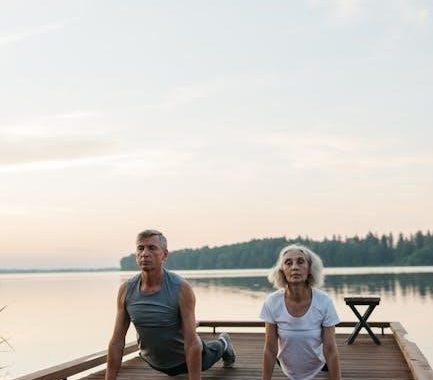Yoga exercises for seniors, including chair yoga, offer gentle, accessible practices to improve mobility, strength, and overall well-being. These routines cater to older adults with limited mobility, promoting flexibility and relaxation while enhancing posture and balance. Yoga for seniors is a safe and effective way to maintain physical health and mental calmness, making it an ideal activity for daily routines.
Importance of Yoga for Older Adults
Yoga is a vital practice for older adults, offering numerous physical and mental benefits. It enhances flexibility, strength, and balance, reducing the risk of falls and injuries. Regular yoga practice improves posture, alleviates chronic pain, and strengthens core and back muscles, which are essential for mobility. Additionally, yoga promotes relaxation and reduces stress, fostering mental well-being and emotional resilience. For seniors with limited mobility, chair yoga provides a safe and accessible way to stay active. It also encourages deep breathing, improving lung capacity and overall cardiovascular health. Yoga not only supports physical health but also creates a sense of community, combating loneliness and isolation. By incorporating yoga into their routine, older adults can maintain independence, improve quality of life, and age gracefully;
Benefits of Chair Yoga for Seniors
Chair yoga is a highly beneficial practice for seniors, offering a gentle and accessible way to improve physical and mental health. By performing exercises while seated, seniors can enhance flexibility, mobility, and strength without putting strain on joints. Chair yoga is particularly effective for those with limited mobility, as it allows them to participate comfortably. It strengthens core and back muscles, improving posture and reducing the risk of injuries. Additionally, chair yoga promotes relaxation through deep breathing techniques, alleviating stress and anxiety. It also enhances balance and coordination, which are crucial for preventing falls. Furthermore, chair yoga supports cardiovascular health and improves circulation, contributing to overall well-being. This form of exercise is ideal for seniors who want to stay active, maintain independence, and enjoy the therapeutic benefits of yoga in a safe and supportive manner.
How to Get Started with Senior-Friendly Yoga
Getting started with senior-friendly yoga is straightforward and accessible. Begin by consulting a physician to ensure the practice is safe for your current health conditions. Invest in a sturdy chair for support, as many exercises are performed while seated. Start with gentle movements and breathing techniques, such as Ujjayi (Ocean Breath), to calm the mind and warm up the body. Focus on slow, controlled motions to avoid strain. Practice seated poses like the Cat-Cow stretch or Shoulder Rolls to improve flexibility and mobility. Consider using yoga props like blocks or straps to modify poses for comfort. Join a class tailored for seniors or follow guided videos to ensure proper form and safety. Begin with short sessions and gradually increase duration as you build confidence and strength. Remember, the goal is to embrace the practice at your own pace, fostering relaxation and overall well-being.
Physical Benefits of Yoga for Seniors
Yoga enhances flexibility, strengthens core and back muscles, improves posture, and boosts balance. It supports mobility and overall physical health for seniors in a gentle, accessible way.
Improving Flexibility and Mobility
Yoga exercises, particularly chair yoga, are highly effective for improving flexibility and mobility in seniors. Gentle stretches like the seated cat-cow and hand clasp rotations enhance range of motion, reducing stiffness in the neck, shoulders, and spine. These movements are low-impact, making them ideal for older adults with limited mobility. Regular practice helps maintain joint health, allowing seniors to perform daily activities with greater ease. Chair yoga also strengthens connective tissues, improving overall flexibility without strain. By incorporating these exercises, seniors can enjoy better mobility, reducing the risk of injury and promoting independence. Breathing techniques, such as Ujjayi Breathing, further enhance relaxation, making the practice more enjoyable and beneficial. Yoga for seniors is a safe and accessible way to maintain physical freedom and vitality in golden years.
Strengthening Core and Back Muscles
Chair yoga exercises are excellent for strengthening the core and back muscles, which are essential for maintaining good posture and reducing back pain in seniors. Simple poses like the Seated Cat-Cow and Seated Spinal Twist gently engage the abdominal muscles and strengthen the back. These movements also improve spinal alignment, which is crucial for preventing injuries and enhancing overall stability. Strengthening the core and back muscles through yoga helps seniors maintain balance, reduce the risk of falls, and perform daily activities with greater confidence. Additionally, these exercises can be modified to suit individual mobility levels, making them accessible to all. Regular practice promotes a stronger, healthier back and core, contributing to improved posture and reduced discomfort in older adults.
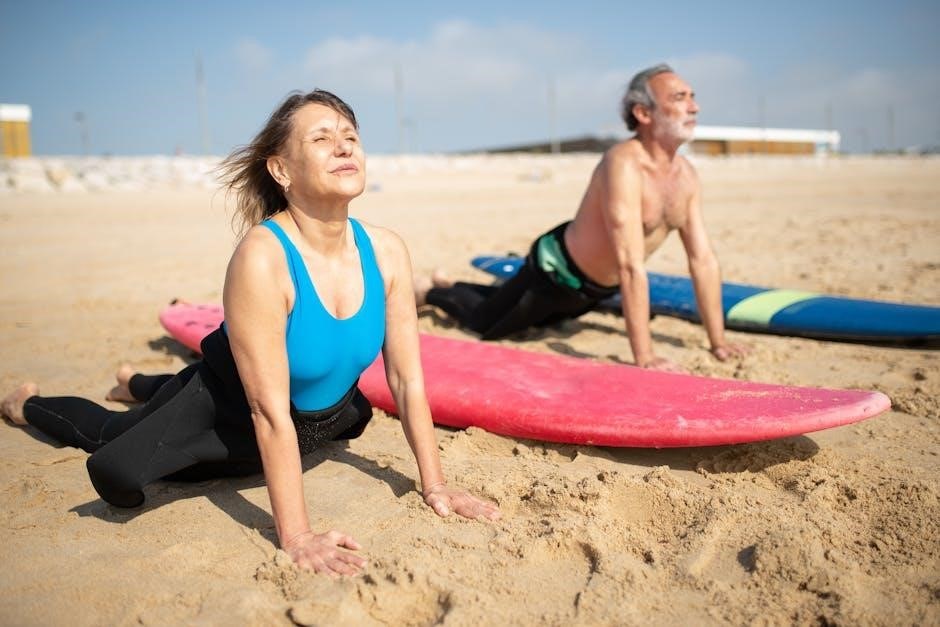
Enhancing Posture and Balance
Yoga exercises for seniors are highly effective in enhancing posture and balance, which are critical for preventing falls and maintaining independence. Gentle movements like the Seated Cat-Cow and Seated Spinal Twist improve spinal alignment, promoting better posture. Chair yoga also incorporates breathing techniques, such as Ujjayi Breathing, which helps stabilize the body and enhance balance. By strengthening the core and improving flexibility, these exercises reduce swaying and promote steadiness. Even simple seated poses can enhance proprioception, the body’s ability to sense its position, further improving balance. Regular practice of these exercises helps seniors maintain upright posture and reduces the risk of falls, fostering confidence in daily activities; This makes yoga an invaluable tool for improving both physical stability and overall well-being in older adults.
Popular Chair Yoga Exercises for Seniors
Popular chair yoga exercises for seniors include gentle stretches like Seated Cat-Cow, Chair Forward Bend, and Seated Spinal Twist. These poses improve mobility, posture, and relaxation, making them ideal for older adults.
Seated Cat-Cow Stretch
The Seated Cat-Cow Stretch is a gentle and accessible exercise for seniors, promoting flexibility and relaxation. Begin by sitting comfortably with feet flat on the floor and hands resting on knees. Inhale deeply, arching the back, and lifting the chest and head toward the ceiling (Cow Pose). Exhale slowly, rounding the spine, and tucking the chin toward the chest (Cat Pose). Repeat this sequence several times, syncing breath with movement. This stretch improves posture, relieves tension in the neck and shoulders, and enhances spinal mobility. It is particularly beneficial for seniors with limited mobility, as it can be performed while seated and at a comfortable pace. Regular practice helps reduce stress and promotes overall well-being.
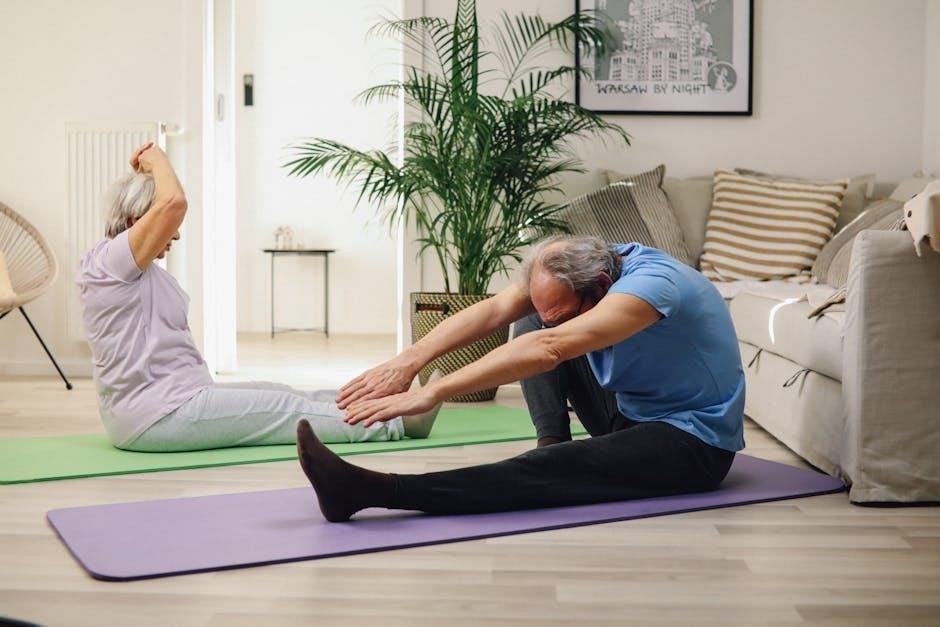
Chair Forward Bend
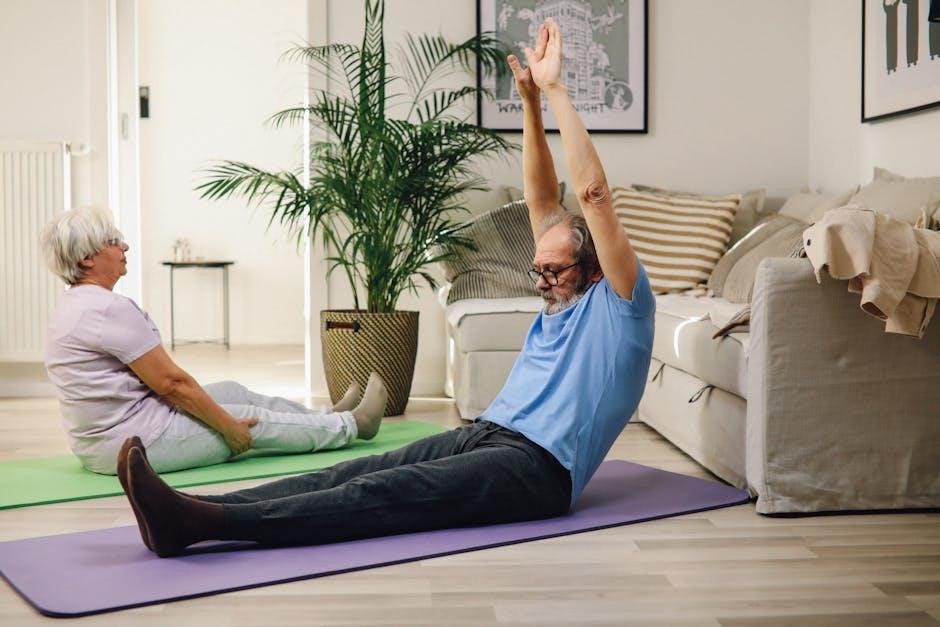
The Chair Forward Bend is a simple yet effective exercise for seniors that promotes flexibility and relaxation. To perform this pose, sit comfortably in a sturdy chair with feet flat on the floor. Place your hands on your thighs just above the knees. Inhale deeply, then exhale slowly as you bend forward from the hips, allowing your arms to slide down your legs toward your ankles. Keep your spine long and your neck relaxed. Hold the pose for 2-3 breaths before slowly returning to an upright position. This exercise stretches the hamstrings, calves, and back muscles while relieving tension in the shoulders. It is particularly beneficial for improving circulation and reducing stiffness. For seniors with limited mobility, this pose can be modified by bending only as far as feels comfortable. Deep breathing enhances the calming effects of the stretch.
Seated Spinal Twist
The Seated Spinal Twist is a gentle yoga exercise that enhances flexibility and mobility in the torso. To perform this pose, sit upright in a sturdy chair with feet flat on the floor. Place your right hand on the outside of your left knee and your left hand on the armrest or thigh for support. Inhale deeply, then exhale as you twist your torso to the left, keeping your hips facing forward. Hold for 2-3 breaths, breathing deeply to deepen the stretch. Slowly return to the starting position and repeat on the opposite side. This exercise improves spinal flexibility, relieves tension in the back and shoulders, and promotes better posture. For seniors with limited mobility, the twist can be modified to a gentle turn. Regular practice helps maintain spinal health and enhances overall circulation.
Shoulder Rolls and Chest Openers
Shoulder Rolls and Chest Openers are simple yet effective exercises for seniors to relieve tension and improve posture. To begin, sit comfortably in a chair with your feet flat on the floor. Roll your shoulders forward and up toward your ears, then back and down, repeating this motion 5-7 times. This helps relax the shoulder muscles and reduce stiffness. Next, place your hands behind your back and gently interlace your fingers. Take a deep breath in, and as you exhale, press your chest forward, opening your shoulders and expanding your chest. Hold for 2-3 breaths before releasing. This movement enhances lung capacity and promotes better spinal alignment. Regular practice of Shoulder Rolls and Chest Openers can improve circulation, reduce upper body tension, and boost overall comfort. These exercises are perfect for incorporating into a daily routine for seniors.
Hand Clasp Rotations
Hand Clasp Rotations are a gentle and effective yoga exercise for seniors, designed to improve joint mobility and reduce stiffness in the hands and wrists. To perform this exercise, sit comfortably in a chair with your feet flat on the floor. Extend your arms straight out in front of you at shoulder height. Clasp your hands together, interlocking your fingers, and gently rotate your wrists in a circular motion—first clockwise for 5-7 rotations, then counterclockwise for the same number of repetitions. This exercise helps maintain flexibility in the wrists and fingers, which is particularly beneficial for seniors with limited mobility. Deep breathing can be incorporated to enhance relaxation and focus. Hand Clasp Rotations are an excellent addition to a daily yoga routine, promoting circulation and reducing tension in the upper body. Regular practice can also improve dexterity and overall hand function.

Breathing Techniques for Seniors
Breathing techniques are essential for relaxation and calmness in senior yoga. Practices like Ujjayi, Box Breathing, and Belly Breathing improve oxygen flow, reduce stress, and enhance overall well-being.
Ujjayi Breathing (Ocean Breath)
Ujjayi, or Ocean Breath, is a calming technique that involves breathing through the nose with a slight constriction in the throat, creating a soft hissing sound. This practice is particularly beneficial for seniors as it promotes relaxation, reduces stress, and improves respiratory function. By slowing down the breath, Ujjayi helps in focusing the mind and preparing the body for meditation or gentle stretches. It is often incorporated into chair yoga routines for its accessibility and effectiveness. Regular practice can enhance oxygen flow, stabilize emotions, and contribute to overall well-being, making it an excellent addition to a senior’s daily yoga practice. It is easy to learn and can be done while seated comfortably, making it ideal for those with limited mobility.
Box Breathing for Calmness
Box Breathing, or Square Breathing, is a simple yet powerful technique to cultivate calmness and focus. It involves breathing in for a count of four, holding the breath for four counts, exhaling for four counts, and holding again for four counts, creating a “box” pattern. This method is particularly beneficial for seniors as it helps reduce stress and anxiety by grounding the mind in the present moment. The structured rhythm of Box Breathing enhances oxygen flow and promotes relaxation, making it an excellent practice for improving emotional stability. It can be done while seated or standing, requiring no physical strain, and is easily incorporated into daily routines. Regular practice supports mental clarity and overall well-being, providing seniors with a practical tool for managing stress and maintaining calmness in their daily lives.
Belly Breathing for Relaxation
Belly Breathing, also known as diaphragmatic breathing, is a deeply relaxing technique that engages the diaphragm, promoting a sense of calm and reducing stress. Unlike shallow chest breathing, Belly Breathing involves allowing the abdomen to rise with each inhale and fall with each exhale. This practice is particularly beneficial for seniors, as it improves oxygen flow, lowers blood pressure, and eases tension. To practice, sit or lie down comfortably, place one hand on the chest and the other on the abdomen. Inhale deeply through the nose, allowing the abdomen to expand while the chest remains still. Exhale slowly, feeling the abdomen drop. This method fosters deep relaxation, making it an excellent addition to a daily yoga routine for seniors seeking to unwind and enhance their overall well-being.

Safety Considerations for Senior Yoga
Consulting a physician before starting yoga is crucial for seniors to ensure safety. Avoiding exercises that cause pain and using props like chairs or blocks for support is essential.
Consulting a Physician Before Starting
Consulting a physician before starting yoga is essential for seniors to ensure safety and suitability. A doctor can evaluate health conditions, such as joint issues or chronic pain, and provide clearance for exercise. This step helps prevent potential injuries and ensures the practice is tailored to individual needs. Medical clearance is particularly important for those with mobility challenges or underlying health concerns. Yoga, while generally safe, may need modifications based on personal health status. A physician can also recommend specific poses or precautions to follow. This initial consultation ensures seniors begin their yoga journey confidently and safely, avoiding complications. It’s a crucial step to maximize benefits and minimize risks associated with starting a new exercise routine.
Avoiding Injuries in Yoga Practice
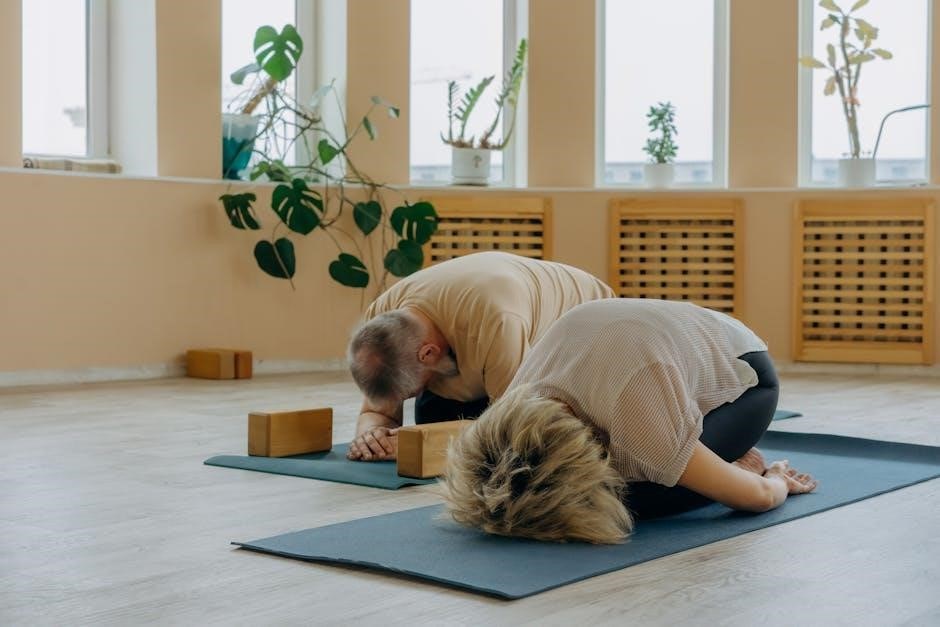
Avoiding injuries in yoga practice is crucial for seniors, especially those with limited mobility or health conditions. Listening to your body and honoring its limits is key. Proper alignment and technique are essential to prevent strain or discomfort. Seniors should avoid forcing poses or overexertion, as this can lead to muscle pulls or joint pain. Using props, such as chairs or blocks, can help modify poses safely. Breathing techniques, like Ujjayi or belly breathing, promote relaxation and reduce tension. Moving slowly and mindfully between poses minimizes the risk of accidents. Starting with gentle stretches and gradually increasing intensity ensures a safe practice. Instructors should be informed of any physical limitations to provide appropriate modifications. Prioritizing safety ensures yoga remains a beneficial and enjoyable experience for seniors.
Modifications for Limited Mobility
Modifications for limited mobility are essential for seniors to safely enjoy yoga. Chair yoga is a popular adaptation, allowing participants to practice while seated, which reduces strain on joints and improves accessibility. Props like blocks, straps, or pillows can support the body in various poses, ensuring comfort and proper alignment. For those with flexibility challenges, gentle stretches and slower movements are recommended to prevent discomfort. Breathing techniques, such as Ujjayi or belly breathing, can enhance relaxation without physical strain. Instructors often suggest alternatives to standing poses, such as seated or wall-supported versions, to accommodate mobility limitations. Additionally, focusing on controlled, deliberate movements helps maintain balance and stability. These modifications ensure that seniors with limited mobility can benefit from yoga while minimizing the risk of injury or discomfort.
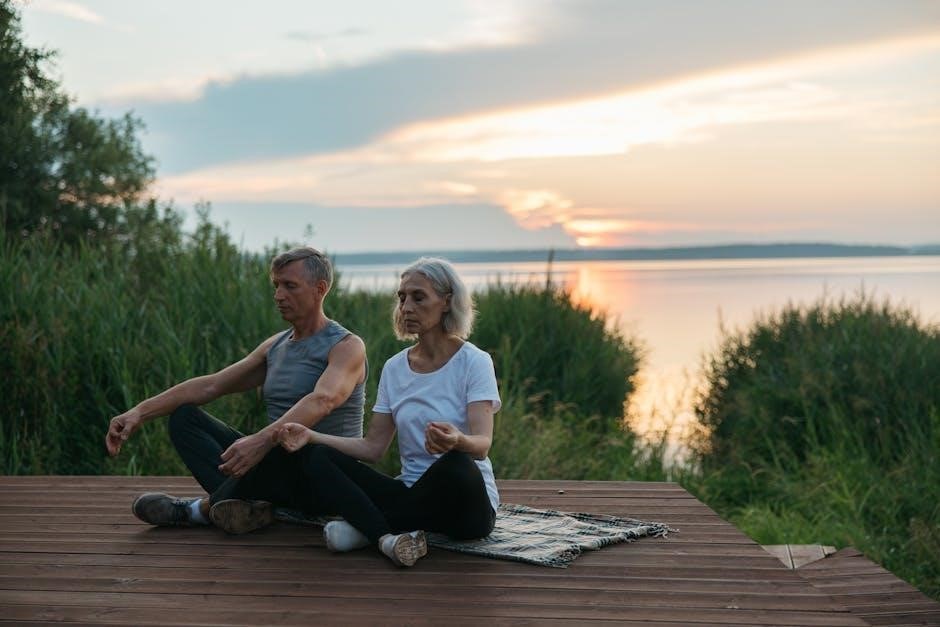
Creating a Daily Yoga Routine for Seniors
A daily yoga routine for seniors combines gentle exercises with breathing techniques, using props for support. This enhances strength, flexibility, and mental calm, promoting overall well-being.
Morning Yoga Routine for Energy
A morning yoga routine for seniors can boost energy and set a positive tone for the day. Begin with gentle breathing exercises, such as Ujjayi (Ocean Breath), to awaken the body and calm the mind. Incorporate seated stretches like the Cat-Cow pose to warm up the spine and improve flexibility. Neck and shoulder rolls can help release tension and enhance circulation. Follow with seated twists to stimulate digestion and energize the torso. Finish with chest openers and arm circles to expand the chest and increase oxygen flow. End the routine with a few minutes of deep, belly breathing to ground and refresh the body. This gentle yet invigorating practice is perfect for seniors, promoting vitality and preparing them for the day ahead.
Evening Yoga Routine for Relaxation
An evening yoga routine for seniors focuses on relaxation and preparing the body for rest. Begin with gentle seated forward bends to release tension in the hamstrings and lower back. Incorporate slow, deep breathing exercises, such as Box Breathing or Belly Breathing, to calm the mind and reduce stress. Seated spinal twists can help improve circulation and promote relaxation, while shoulder rolls and neck stretches ease muscle tightness. End the routine with a restful seated forward fold or a guided meditation to quiet the mind. This practice helps seniors unwind after a busy day, promoting better sleep quality and overall well-being. By incorporating these gentle exercises, seniors can enjoy a peaceful transition into the evening, feeling refreshed and calm.
Incorporating Breathing Exercises into Daily Life
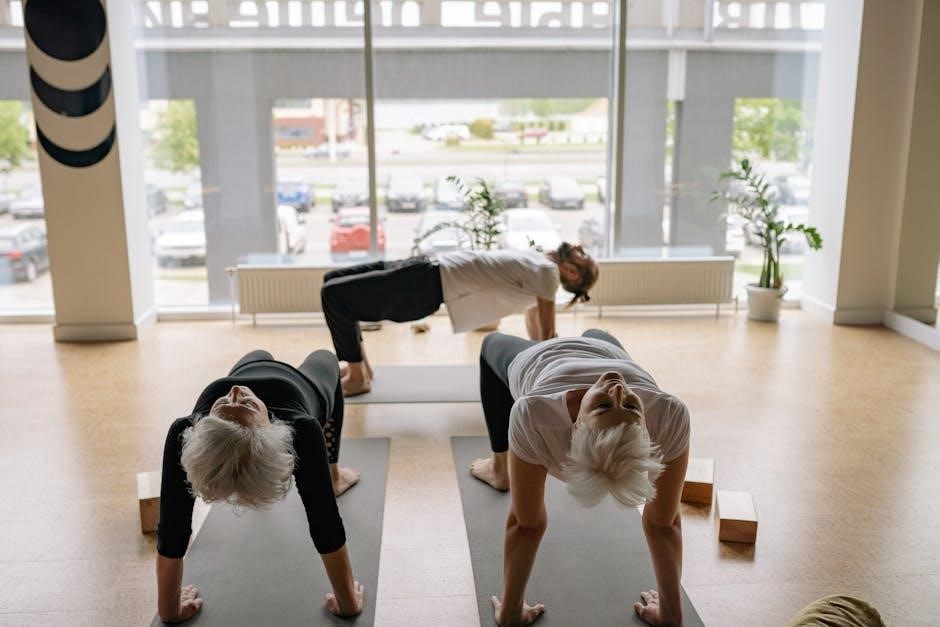
Incorporating breathing exercises into daily life is a simple yet powerful practice for seniors. Techniques like Ujjayi (Ocean Breath) and Box Breathing can be done anywhere, even while seated. These exercises help calm the mind, reduce stress, and improve oxygen flow. Start by dedicating a few minutes each morning to practice deep belly breathing, which strengthens the diaphragm and promotes relaxation. Throughout the day, take short breaks to perform a few rounds of Box Breathing: inhale for 4 counts, hold for 4, exhale for 4, and hold again for 4. This creates a sense of balance and focus. Even while performing daily tasks, such as walking or preparing meals, seniors can integrate conscious breathing to enhance calmness and energy. By making these exercises a habit, seniors can improve their overall well-being and maintain a peaceful state of mind.
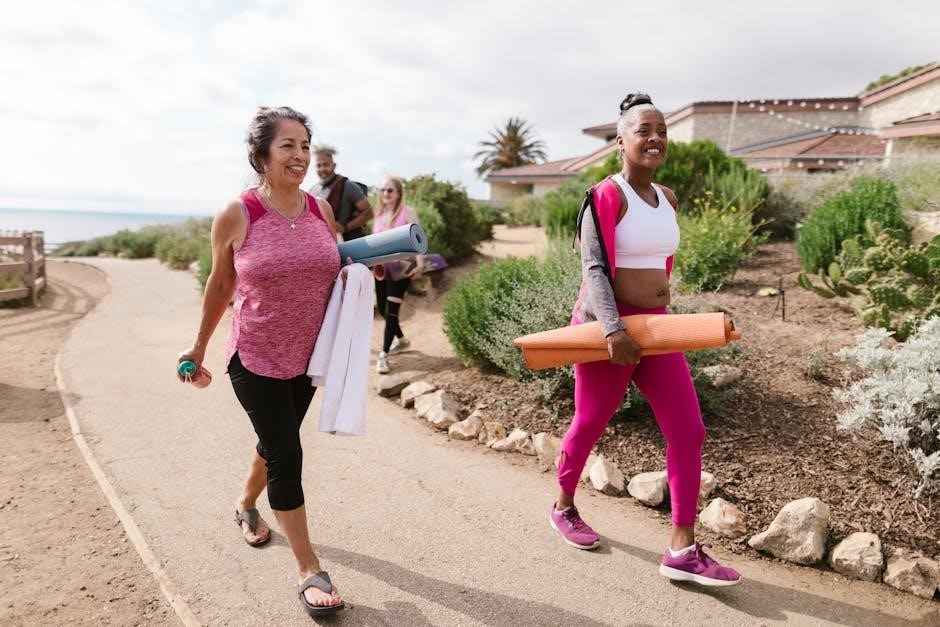
Yoga Props and Accessories for Seniors
Yoga props like chairs, blocks, and straps provide essential support and stability for seniors, making exercises accessible and safe while enhancing comfort during practice.
Using a Chair for Support
Using a chair for support in yoga is highly beneficial for seniors, especially those with limited mobility. A sturdy chair provides stability, allowing seniors to perform exercises safely and confidently. Chair yoga modifies traditional poses to be more accessible, focusing on seated movements that improve flexibility, strength, and posture. It is particularly gentle on the back and knees, making it ideal for older adults with joint pain or mobility challenges. Chairs also enable proper alignment and balance, reducing the risk of falls. Many exercises, such as the Seated Cat-Cow stretch or Hand Clasp Rotations, rely on a chair for support. This approach ensures that seniors can enjoy the benefits of yoga without strain, making it a cornerstone of senior-friendly yoga practices. Chairs are versatile and essential props for creating a safe and effective yoga routine tailored to older adults’ needs.
Benefits of Yoga Blocks and Straps
Yoga blocks and straps are invaluable props for seniors, enhancing accessibility and comfort in practice. Blocks provide height and support, allowing seniors to maintain proper alignment without straining. They are especially useful for poses requiring reaching or balancing, ensuring safety and stability. Straps help deepen stretches and maintain poses, offering gentle assistance for tight muscles or limited mobility. Both props enable seniors to enjoy the benefits of yoga without discomfort or risk of injury. They are versatile tools that support flexibility, strength, and relaxation, making yoga more inclusive for older adults. By using blocks and straps, seniors can modify poses to suit their abilities, ensuring a safe and enjoyable practice tailored to their needs.
Yoga enhances flexibility, strength, and mental well-being in seniors. Chair yoga is accessible, enabling comfortable practice. Regular sessions boost health and quality of life.
Final Thoughts on Yoga for Seniors
Yoga is a life-enhancing practice that offers numerous benefits for seniors, improving physical health, mental well-being, and emotional balance. Chair yoga, in particular, is an accessible and gentle form of exercise that accommodates limited mobility, making it ideal for older adults. Regular practice can enhance flexibility, strengthen muscles, and improve posture while reducing stress and anxiety. Seniors can start slowly, incorporating breathing techniques like Ujjayi and Box Breathing to promote relaxation. It’s essential to consult a physician before beginning any new routine and to use props like chairs, blocks, and straps for support. Yoga fosters a sense of community and connection, which is vital for emotional health. Consistency is key, as even short daily sessions can lead to significant improvements in overall quality of life. Embrace yoga as a holistic approach to aging gracefully and maintaining vitality.
